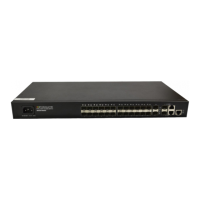Command Line Interface
tool (such as ping and tracert), command of switch between different language environments
of user interface (language-mode) and telnet command etc and including the display
command and the debugging command, are used to system maintenance, service fault
diagnosis, etc. The operation of saving configuration file is not allowed on this level of
commands.
Configuration level: Service configuration commands, including routing command and
commands on each network layer are used to provide direct network service to the user.
Management level: They are commands that influence basis operation of the system and
system support module, which plays a support role on service. Commands of this level
involve file system commands, FTP commands, TFTP commands, Xmodem downloading
commands, user management commands, and level setting commands.
At the same time, login users are classified into three levels that correspond to the three
command levels respectively. After users of different levels logging in, they can only use
commands at the levels that are equal to or lower than their own level.
In order to prevent unauthorized users from illegal intrusion, user will be identified when
switching from a lower level to a higher level with username username [privilege level]
{password encryption-type password} command. For the sake of confidentiality, on the screen
the user cannot see the password that he entered. Only when correct password is input for
three times, can the user switch to the higher level. Otherwise, the original user level will
remain unchanged.
Different command configuration mode is implemented according to different requirements.
They are related to one another. For example, after logging in the Ethernet switch, you will
enter user mode, in which you can only use some basic functions such as displaying the
running state and statistics information. In user mode, key in enable to enter privileged mode,
in which you can key in different configuration commands and enter the corresponding
configuration modes.
The command line provides the following configuration modes:
User Mode
Privileged Mode
Global Configuration Mode
Interface Configuration Mode
VLAN Configuration Mode
AAA Configuration Mode
RADIUS Configuration Mode
Domain Configuration Mode
VLAN-interface Configuration Mode

